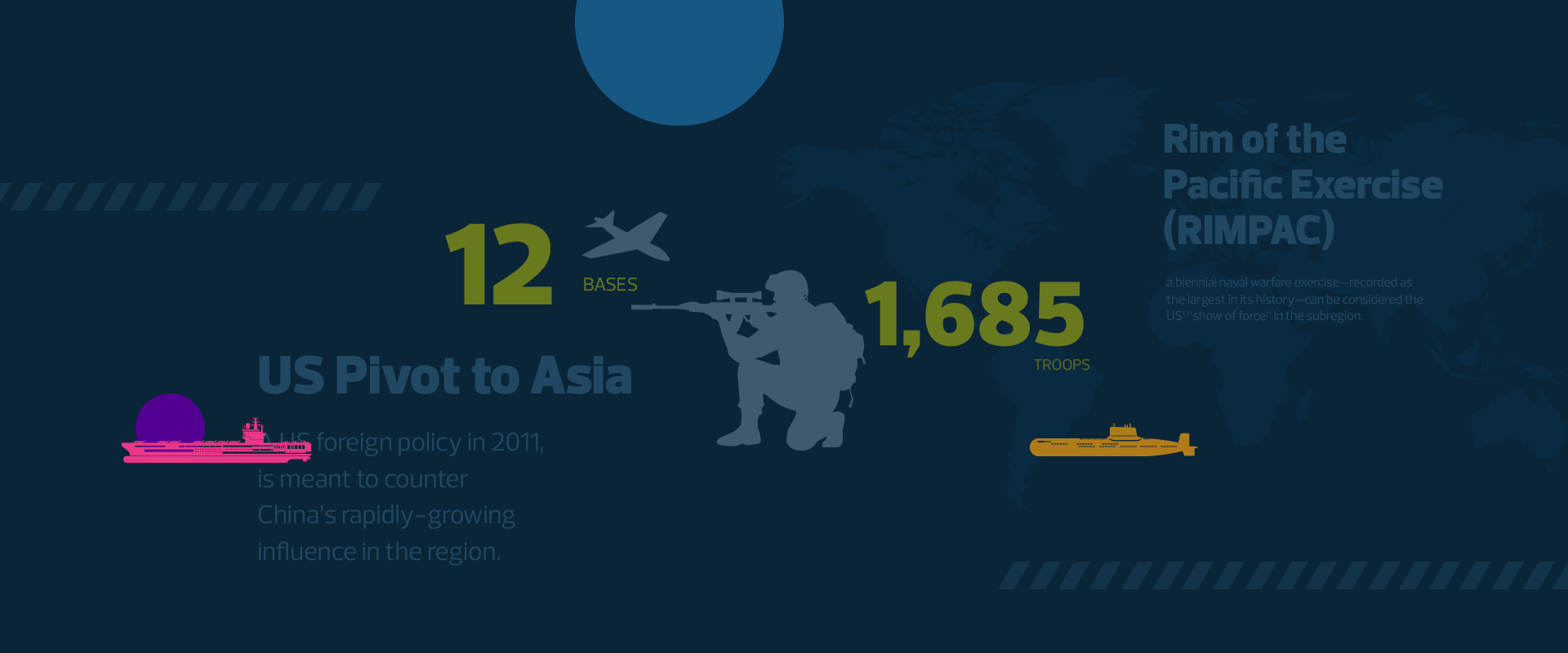The United States continues to be the world’s top military spender. It spent USD 877 billion in 2022, surpassing the military expenditures of the succeeding ten countries combined (SIPRI, 2022).
The billions of dollars are spent on producing war materiel, investing in military research and technology, and maintaining its military presence outside American soil.
Currently, the US military is present in more than 80 countries with 750 bases across the globe in the guise of global peace-keeping and security (Vine, 2021).
In the past decade, the US hegemony in Asia and in the world was challenged by the rise of China and Russia as formidable contending powers. The US is now exhausting everything in its arsenal to assert itself as the sole global superpower.
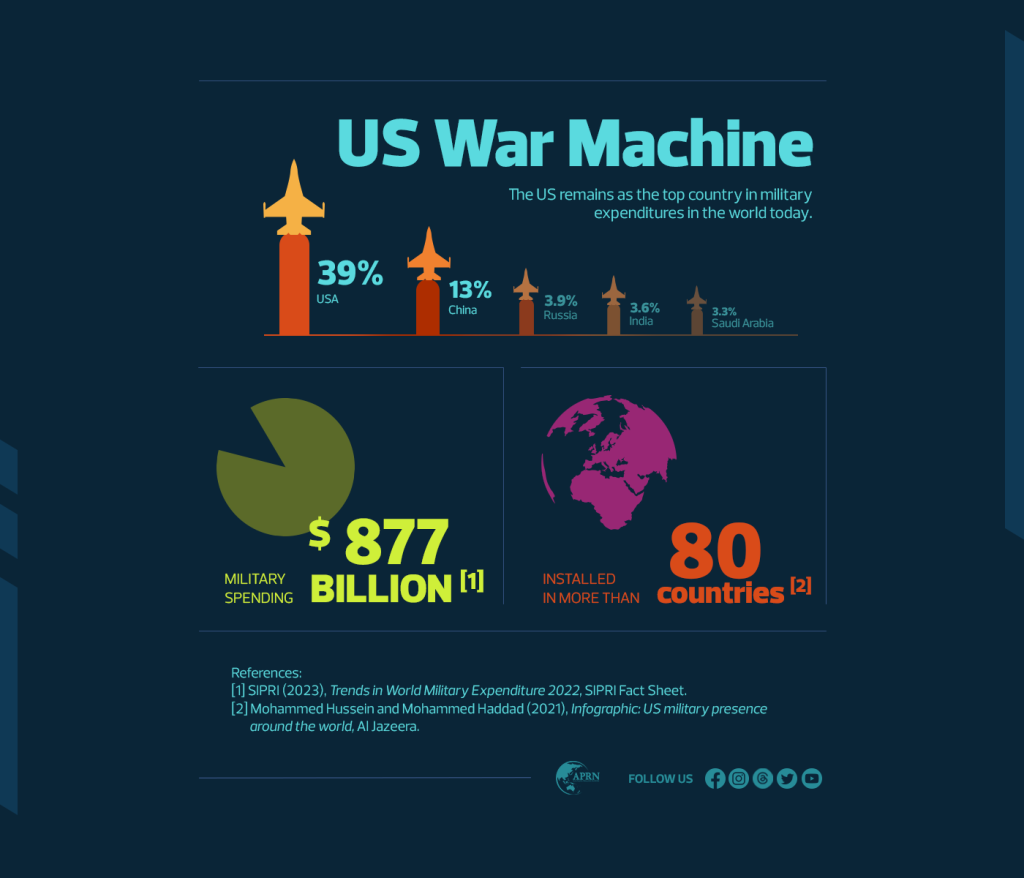
West Asia
Despite its withdrawal of troops from Afghanistan, ending its 20-year occupation of the country, the US maintains its presence in West Asia through bases and military facilities in almost every country surrounding Iran as the US considers them as a threat and challenge to its hegemony in the subregion. Most of these are located and concentrated in the Gulf countries namely Saudi Arabia, Kuwait, and Bahrain. (Vine, 2021)
However, the US military foothold in these countries is meant primarily to advance and protect its interest in oil reserves and other resources (Chomsky, 2004). It sustains its political influence through its Global War on Terror which contradicts its own policies in connecting to the Muslim world (Maghraoui, 2006).
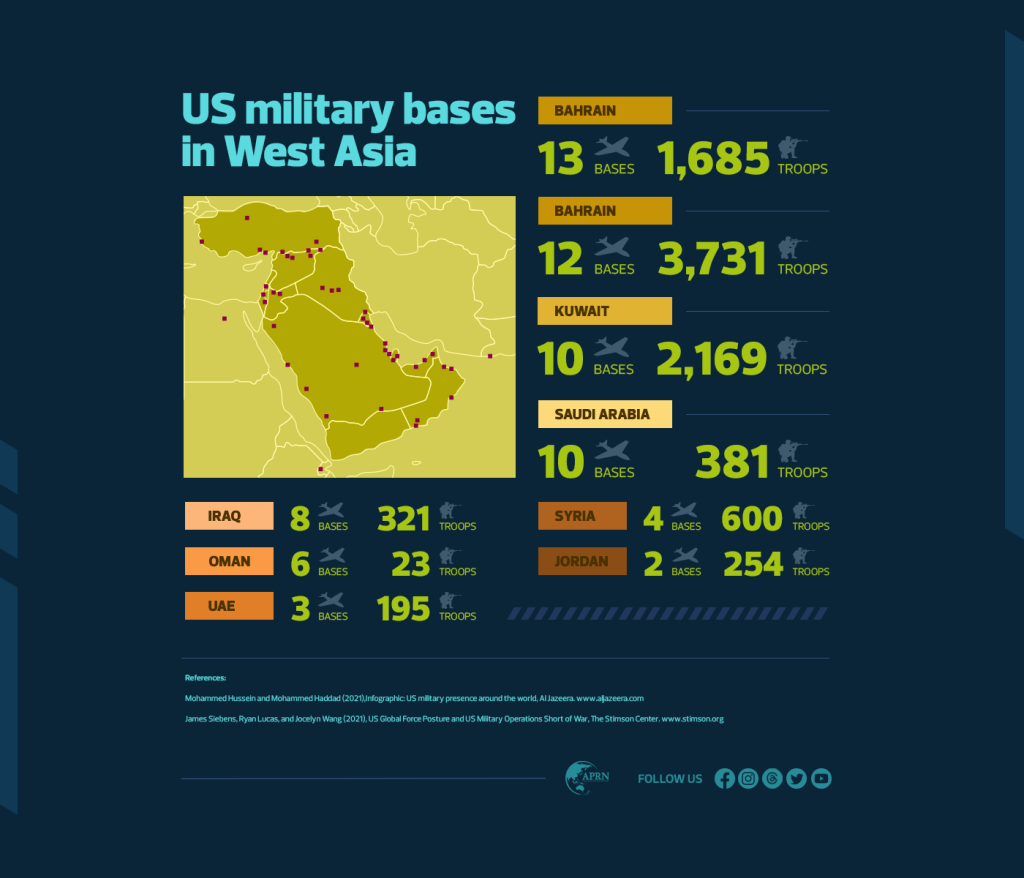
Northeast Asia
The US “Pivot to Asia” strategy is meant to counter China’s rapidly-growing influence in the region. Since 2011, it has buttered up its political and military allies in East Asia.
After World War II (WWII) and Japan’s defeat, the country entered a bilateral security treaty with the US in 1952. Five years later, Japan began to host US military forces and facilities across the country with a concentration on the island of Okinawa. Japan became instrumental in ensuring US presence in the subregion from thereon. In 2022, Japan spent a whopping USD 8 billion to support the US military stationed on its soil in the face of a “growing threat from China, the nuke-powered North Korea, and Russia”.
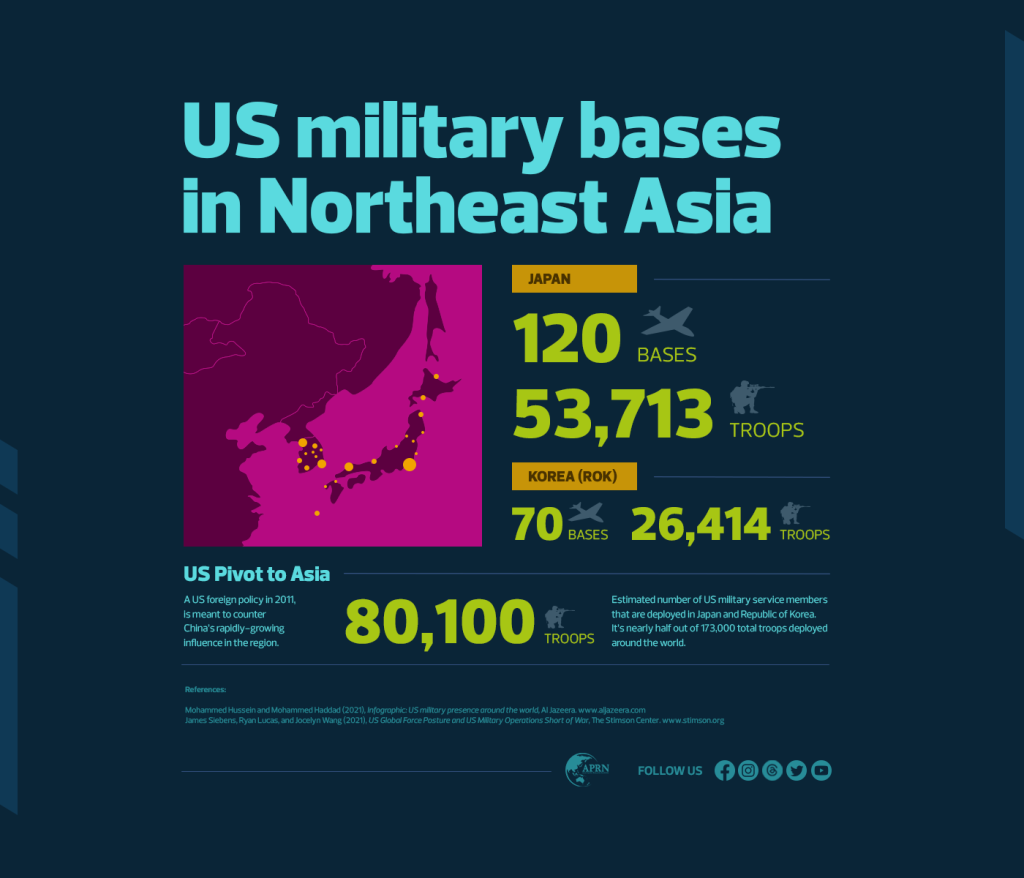
The same reason is used by the US to maintain its toehold in South Korea. After the civil war and the partition of the Korean peninsula, the Republic of Korea and the US signed its Mutual Defense Treaty. This year has seen the biggest Foal Eagle activities, the annual joint military exercise between the two countries, since its suspension in 2018. In the guise of fending off the “Communist North Korean threat”, the US effectively hinders Korea’s reunification.
The US is also strengthening its military ties with Taiwan. Although it no longer hosts US military bases and personnel since 1979, the Taiwanese government said that it will “cooperate more actively” with the US to combat China’s expansionist threat.
Pacific
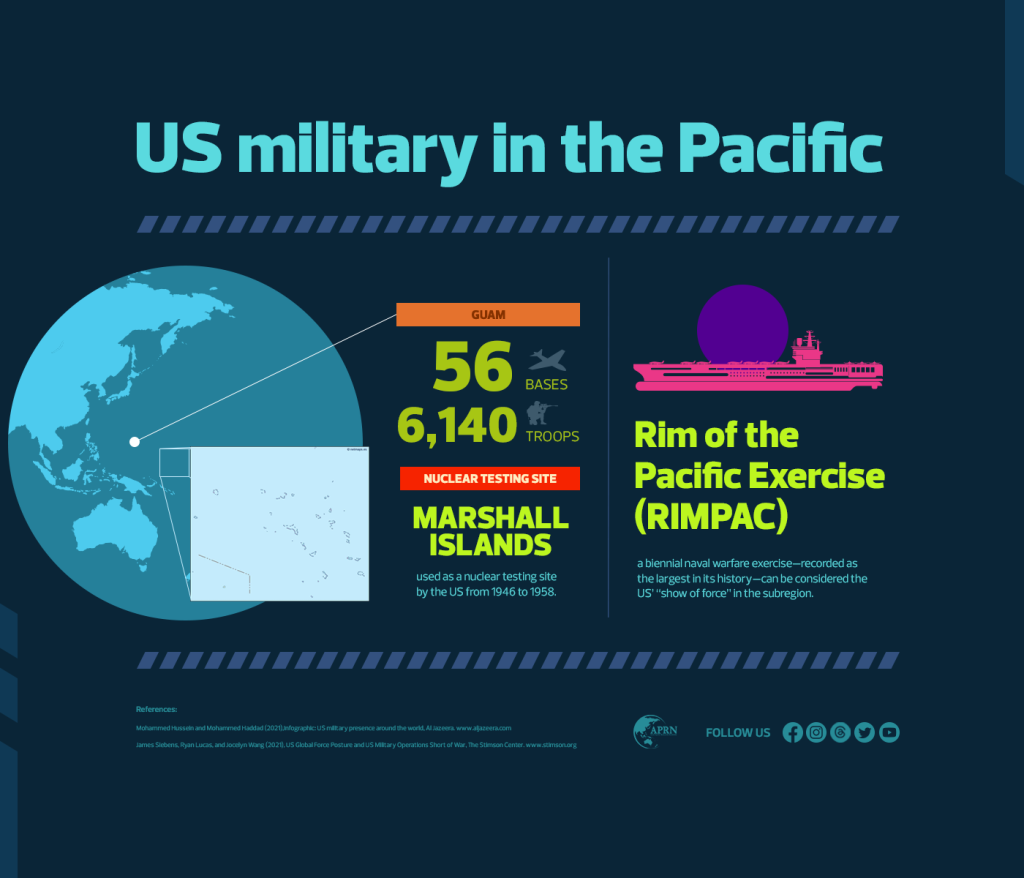
Aiming to contain its rival superpowers and maintain its global hegemony, the US also ensured its presence in the Pacific. The RIMPAC (Rim of the Pacific), a biennial naval warfare exercise—recorded as the largest in its history—can be considered the US’ “show of force” in the subregion.
The Marshall Islands have been used as a nuclear testing site by the US from 1946 to 1958 and have suffered loss and damages and are yet to be compensated. Moreover, the US controls a handful of its military facilities there.
The same goes for Guam which remains a US territory and military zone and is peppered with over 33 bases and 22 lily pads (Vine, 2021) with a new one opened just last January.
The recent and pending US-Pacific Island Fourm Partnership Act is a new step to strengthen and cement its control in the subregion.
Despite these, the US is still expanding its military-industrial complex in the subregion’s immediate vicinity.
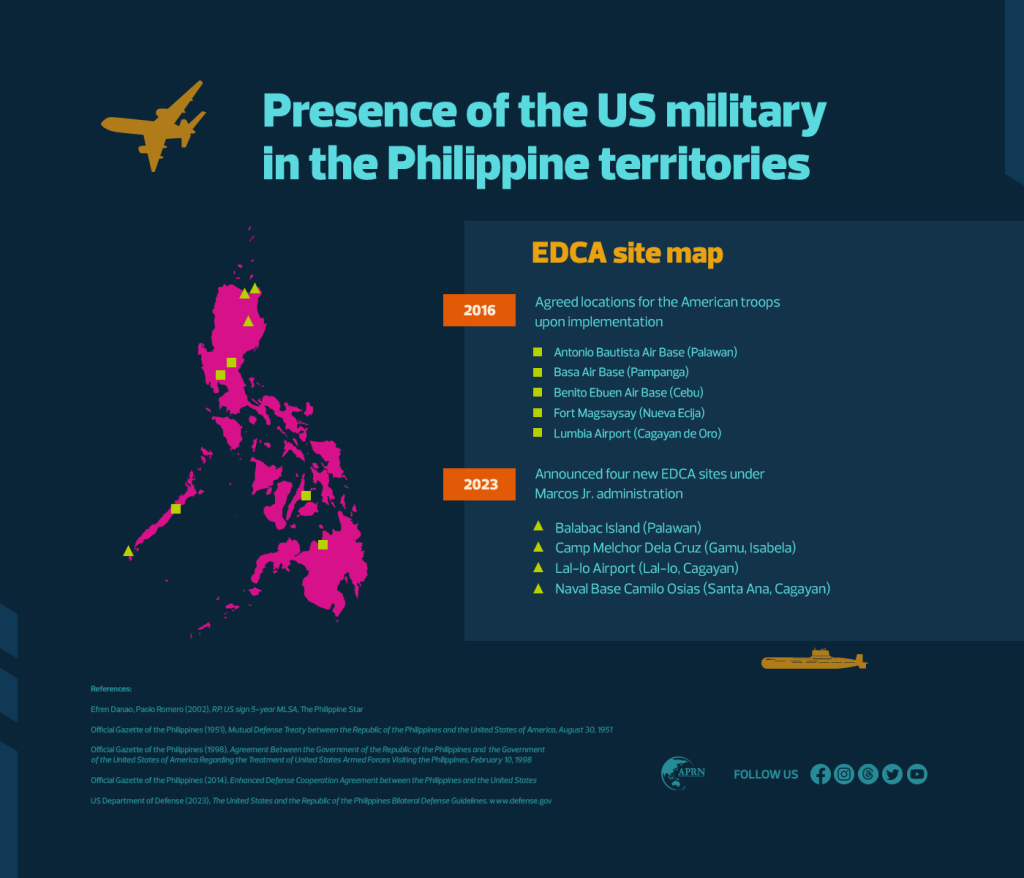
The Philippines
Considered its oldest ally in the Southeast, the Philippines has been a historically strategic and indispensable country to the US since the late 1800s and even after WWII.
The oldest active military agreement between the two countries is its Mutual Defense Treaty (MDT). Enacted in 1951, the treaty enabled the US to implicate the Philippines in conflicts it considers a “common danger”.
From the ‘60s to the ‘80s, the presence of the US military bases was opposed by Filipinos which eventually led to its termination in 1992.
But the US did not leave the Philippines.
In 2002, the Mutual Logistics Support Agreement (MLSA) was signed by the two countries which allowed the US military to store its equipment, supplies, and other arsenal in the Philippines.
On the other hand, the Visiting Forces Agreement (VFA) enacted in 2004 allowed US military forces to enter the country back and forth. This law has led to the annual Balikatan (literally “shoulder-to-shoulder” in Filipino) Exercises between the US and the Philippines.
Ten years later, the Enhanced Defense Cooperation Agreement (EDCA) agreement was signed. It was met with resistance as it practically reestablishes US bases in the country. The agreement ensures that the Armed Forces of the Philippines’ (AFP) facilities in “agreed locations” can be used rent-free by the US military.
The current relations between the two governments are being boosted by the installation of a former dictator’s son as the new Philippine president.
Aside from being swiftly congratulated by the Biden administration, Ferdinand Marcos Jr. has visited the US twice within the first year of his administration. Moreover, three top US officials have already paid State visits to the Philippine presidential palace. This is despite the contempt order issued by American courts for the Marcos family’s historic violation of human rights and plunder during its patriarch’s 21-year reign.
Under Marcos Jr’s rule, the biggest Balikatan was held with over 17,600 participating US and Philippine military troops. Additionally, four (4) more “agreed locations” under EDCA were approved.
On May 3, the US-PH Bilateral Defense Guidelines were signed by Marcos Jr as a grand gesture during his White House visit. With this reaffirmation to the MDT, the US can now meddle with the Philippine government’s defense budget, military investment, and other fiscal aspects relating to peace and security. Additionally, it expands the US’ political role in the Philippine military – all in the name of combating “transnational and “nonconventional threats”.
The US needs these developments, as the Philippines is one of its four “force postures” in the Indo-Pacific which includes Japan, Guam, and Australia (IBON Foundation, 2023).
By resurrecting the ghost of the Cold War-era ‘red scare’ and conflating it with China’s expansionist ideals, the US is igniting the possibility of a full-blown war while mouthing ‘peace’. It disregards the right to self-determination and the sovereignty of countries by offering its hand as an ally of justice and champion of democracy.
In fact, the US has a long history of supporting dictators worldwide and subverting democracy. These things considered, the real threat to peace, democracy, and people’s rights is no other than the US.
But while it continues to show its military might and support anti-democratic leaders and policies worldwide, the oppressed people of the world continue the struggle for freedom, liberation, and self-determination.#

